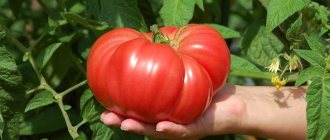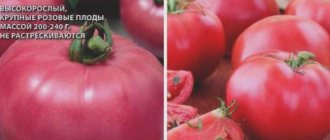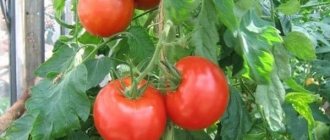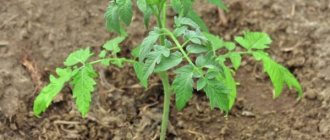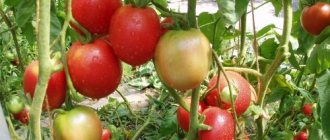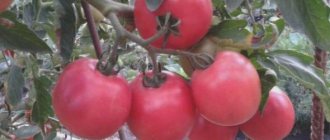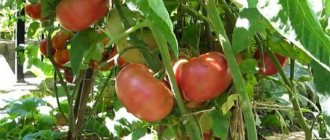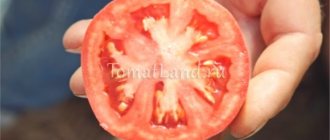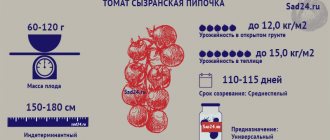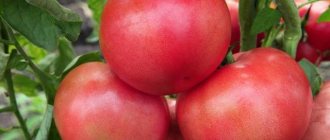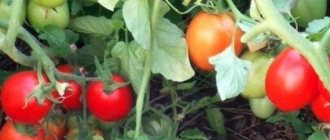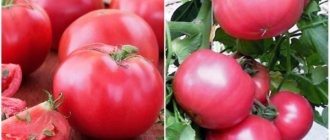Spring is a wonderful and favorite time for amateur gardeners, when the time comes to choose varietal seedlings for planting and take the word of the sellers about the yield of a particular variety of tomatoes. Let's take a fleshy raspberry tomato, characteristics and description of the variety . In order not to get into trouble, today we’ll talk about the crimson beauties that are loved by many. How to grow, care for and fertilize correctly so that the plant pleases you with the yield and excellent taste of its fruits.
Despite the low-growing variety, the handsome Raspberry Fleshy tomato variety has plenty of admirers. This variety is especially appreciated by professional gardeners for its early ripening and generous yield. The first full-fledged harvest ripens 2.5 months after planting in the ground. Very good reviews from fans of summer cottages, easy to care for, does not take much time, produces very few shoots - stepchildren. High resistance to diseases. The crop is distinguished by its beautiful large fruits with juicy pulp, but also strong skin, which makes it easy to transport. Main varietal characteristics •Low-growing tomato variety, reaches a height of 50-60 cm, so there is no special need for a garter. •An early-ripening tomato variety is not distinguished by an abundance of side shoots; there are stepsons, but in rather meager quantities and in the late period. Important! Do not overuse mineral fertilizers to increase yield. It is from an excess of mineral fertilizer that a tomato bush produces many additional shoots, and on the contrary, the yield decreases. •The yield from one bush of the Raspberry fleshy tomato variety reaches 5-6 kg, is distinguished by long-term fruiting •Tomato fruits are large, round, slightly flattened, with an average weight of 200 g •The fleshy and multi-chambered tomato pulp is especially good, juicy and sweet. •Due to the fleshy pulp of tomatoes, this variety contains an increased amount of antioxidants, vitamins and microelements
Helpful advice! It is the Raspberry fleshy tomato variety that is best used for homemade tomato juice, homemade adjika and tomato paste. Thanks to the fleshy, juicy pulp, which is not watery, the prepared products have a thick consistency and a rich tomato taste. When fresh, they are enjoyed in salads and casseroles; tomatoes make excellent hot gravies and sauces. The advantages of the Raspberry Fleshy Tomato variety are: good yield, excellent taste, early ripeness, large fruit, as well as high resistance to a common disease of all tomatoes - verticillium. But this variety of tomato practically has no disadvantages if grown and cared for correctly.
Advantages and disadvantages
Let us highlight the main pros and cons of the “Raspberry Giant” variety of tomatoes. This will help you understand whether you need these tomatoes in your garden or not.
Strengths:
- large fruits and good yield;
- universal table purpose;
- possibility of commercial use;
- long storage;
- relative resistance to diseases.
Weak sides:
- a number of diseases and insects affect the crop;
- may not be grown outdoors everywhere;
- requires attention and time for agricultural technology.
Agree, there are still more advantages. Of course, this tomato will not grow on its own; you will have to take care of it, but the result is still worth it.
Large-fruited pink tomatoes
These are the owners of the largest and most delicious fruits. Every year on my plot I grow 3-4 pink and raspberry varieties especially for fresh salads. Filled with the sultry southern sun, the sweet, aromatic fruits taste like no competition!
Tomato 'Unsized'
A wonderful variety with oblong fruits.
Tomato 'Unsized'
A semi-determinate novelty, 1-1.2 m high. The fruits are pinkish, oblong-elongated, sweet, fleshy, weighing up to 1 kg (the first). Fruiting is prolonged (long). The variety is universal: for growing in open ground (with pinching up to the first cluster) and for greenhouses.
Tomato 'Beef Pink Brandy F1'
The hybrid is considered the best tomato for slicing; The fruits are stored well and for a long time and can be transported without problems.
Tomato 'Beef Pink Brandy F1'
Indeterminate hybrid up to 1.8 m high. Mid-season (75-78 days). The fruits are bright pink, round, weighing 230-330 g, with fleshy juicy sweet pulp of excellent taste. The maturation process is extended over time.
Tomato 'Your Honor'
The name of this new variety evokes associations with the famous song: “Your Honor, Lady Luck...”. My friends tried to grow it in open ground in Crimea, and were very pleased with the results: along with 'Oxheart Pink', this variety also became a favorite among large salad tomatoes.
Tomato 'Your Honor'. Photo from vse-semena.com. Fetus. Photo from farpost.ru
Semi-determinate novelty, 1.2-1.4 m high. Mid-season. The fruits are flat-round, weighing up to 1 kg (especially the first ones), with delicate sugary pulp; not prone to cracking. The fruiting process is extended over time.
Tomato 'Pink Fig'
A variety for real gourmet aesthetes, very unusual in appearance! It is successfully grown by our seven-dacha resident Zinaida Fedorova.
Tomato 'Pink Fig', photo by Zinaida Fedorova
Indeterminate, up to 2-3 m high. Medium early (106-110 days). The fruits are ribbed, pink, weighing up to 350-650 g, with juicy sweet pulp. Zinaida Fedorova shares the details of its cultivation with readers of the site in the material:
- Figs pink
Description of the tomato variety Raspberry wine, its characteristics and yield
Modern farmers and gardeners have very high demands for tomatoes. The variety Raspberry wine f1 can satisfy them. The characteristic suggests that tomatoes produce high yields, are resistant to diseases and are not too demanding to care for. The taste is excellent. What more could a gardener dream of?
Description of the variety
Raspberry wine is a mid-early tomato variety. You can enjoy the first tomato 110 days after germination. The bush is determinate, tall (height reaches 2 meters), standard.
Tomato variety Raspberry wine f1, described in this article, is suitable for growing both in open ground and in greenhouses. Fruits at the stage of technical maturity have a rich red color and a round shape. The pulp is dense.
The weight of one tomato can reach 600 grams, but specimens weighing 250–400 grams are more common. Dry matter content is about 5%. Each fruit has 6 seed chambers.
Raspberry wine tolerates transportation well over long distances and long-term storage, without losing its taste and commercial qualities.
From each bush, up to 9 kg of fruits of excellent quality are collected. Accordingly, the yield per square meter is about 25 kg.
You can find some varieties of the variety that do not differ significantly in their characteristics: Raspberry miracle, Golden Raspberry miracle.
Growing
Raspberry wine is grown using seedlings. Seeds are sown in pre-prepared containers with soil mixture a month before the intended planting in open ground. The containers are placed in a well-lit place.
Otherwise, the plants will stretch out, become thin and may subsequently die. A week before the intended planting, the seedlings are hardened off. For this purpose, raspberry wine f1 is taken out into the open air on the first day for a couple of hours, and then the residence time is increased.
Tomatoes are planted in a permanent location when the air temperature at night is at least 15 °C. Raspberry wine is a tall variety, so no more than 4 plants are placed per square meter.
Features of care
It is recommended to form the bush into 2 stems. Reviews from gardeners indicate that plants require staking. When grown in open ground, this measure will help protect the plantings from the wind and prevent the stem from breaking under the weight of the fruit.
The Raspberry wine variety is demanding both in terms of temperature and humidity. In this regard, mandatory regular watering is required. During the period of growth and fruit formation, tomatoes require fertilizing containing potassium and phosphorus. Subsequently, the amount of fertilizer is reduced, and at the end of the season it is completely stopped.
Advantages and disadvantages
Raspberry wine has a huge number of advantages that distinguish this variety from its competitors. These include:
- good yield;
- increased resistance to major types of diseases;
- simultaneous ripening of fruits;
- excellent varietal qualities;
- universal use of the harvested crop;
- suitability for transportation over long distances;
- suitability for long-term storage.
With all this, tomato Raspberry wine has a minor drawback. The variety turned out to be demanding in terms of watering and light levels. Otherwise, not only the yield is reduced, but also the taste and product characteristics.
Pests and diseases
Tomato Raspberry wine, or as it is popularly called Raspberry, shows excellent resistance to the most common diseases. But plants can be affected by blossom end rot. You can cope with it by reducing the nitrogen content in the soil. For this purpose, calcium is added and soil moisture is increased. Affected bushes are sprayed with calcium nitrate.
Brown spot can also damage Raspberry Wine tomato plantings. For preventive purposes, the number of waterings is reduced, and the greenhouse is regularly ventilated. The Colorado potato beetle causes enormous damage to plants. They fight it by treating the plantings with Prestige.
Slugs are not averse to enjoying the Raspberry wine harvest. They get rid of them by regularly loosening the soil and sprinkling with ground mustard and pepper. For one square meter there is 1 teaspoon of product.
Harvest and storage
Raspberry wine is characterized by friendly fruit production. Tomatoes are perfectly stored and can withstand transportation. Intended primarily for fresh consumption, but also suitable for all types of processing. The first harvest of tomatoes is not suitable for whole-fruit canning due to their large size. The fruits can be picked brown and then ripen in the sun.
Giant
The giant is an early, varietal tomato. It is recommended for all regions, but it is necessary to choose the most suitable growing method. The tomato develops well both in the open garden and in the greenhouse. The plant is determinate, tall:
| № | Helpful information |
| 1 | the fruit is round, there is no ribbing |
| 2 | weight – 200-300 g. Individual berries gain up to 600 g |
| 3 | 2-3 bushes are planted per 1 m2. They collect 5.9 kg |
The branches are tied together with the stalk. Additionally, supports are installed under the hands. According to gardeners, the stem bends under the weight of the fruit, but is not injured. Tomatoes are grown in a sunny area. Fertilizers are introduced throughout the growing season.
Raspberry tomatoes gain sweetness only in sunny areas, but it is recommended to cover them with a protective net to protect them from intense ultraviolet radiation. The fruits may be baked. When exposed to sunlight, green fibrous areas may appear in the pulp.
Advantages and disadvantages of the variety
The Iron Lady tomato variety has a number of advantages:
- Good storage performance;
- The fruits can be collected unripe; they will become ready at room temperature;
- Well transported and not damaged;
- They do not crack during ripening;
- They tolerate temperature changes well;
- Suitable for whole fruit canning;
- Withstands heat and slight drought;
- They are resistant to Verticillium wilt;
- The fruit contains a lot of sugars.
But the disadvantages of this variety should also be taken into account:
- The variety belongs to mid-season tomatoes, so you should be prepared that it will not bear fruit for a long time;
- Wide foliage can block other nearby plantings from the sun;
- It is necessary to pinch the trunk to organize branching;
- Regular stepsoning is required.
We can conclude that the Iron Lady tomato variety is a very convenient variety, not capricious when grown. It tolerates various temperature changes and droughts well: if you fail to water on time, the crop will not be lost. For these reasons, this variety of tomato has long been loved and popular among summer residents.
Raspberry Fountain
Not only large-fruited tomatoes, but also cherry tomatoes can have an attractive raspberry shade of flesh. To decorate salads, culinary dishes and sandwiches, it is proposed to grow Raspberry Fountain on the site.
This is an early ripening, indeterminate hybrid. Up to 20-30 ovaries are formed in one brush. The bunch looks very beautiful:
- the shape of the fruit is plum-shaped, dense;
- weigh no more than 20 g;
- Up to 7-8 brushes are collected from one plant.
In order for the cherry tomatoes on one bunch to ripen at the same time, they are turned towards the sun or additional lighting is installed. The leaves around the cluster are removed so that they do not shade the fruits or draw nutrients onto themselves.
When growing raspberry tomatoes, it is recommended to adhere to agricultural techniques. Complex fertilizers are used for fertilizing.
For full development, plants need potassium, phosphates, and sulfates. To strengthen and stimulate the ovary, supplements with magnesium and boron are introduced. All tomatoes, both varietal and hybrid, require care.
Characteristics and description of tomato Raspberry ringing F1
Bushes of determinate type. They grow to a certain height, and after that all the power of the plant will be directed to the fruits. The root system is underdeveloped and does not go deep. Lateral roots grow to the sides. The bush itself is strong, and until fruits appear on it, it is able to grow without support. Next, the culture needs tying up. The stems stretch to a height of 50 cm in beds and 120 cm in greenhouses. The hybrid does not have thickened foliage. The first inflorescences of the Raspberry Bell appear above the sixth leaf.
Description of fruits:
- weight reaches up to 300 g, diameter 9-10 cm;
- the color is pink-raspberry, uniform, there is no dark spot near the stalk;
- round shape, dense to the touch;
- the skin is smooth, shiny, thin, does not crack;
- the pulp is dense, juicy, aromatic;
- taste sweet;
- There are few seeds, 3-4 seed chambers.
Raspberry ringing tomatoes can be picked unripe. They ripen and acquire the desired ripeness. Productivity is high. About 20 kg of tomatoes are harvested per square meter, and up to 5 kg per bush. The first fruit can be tasted 90 days after the first sprouts appear.
The best varieties of pink tomatoes: top 25 most popular
Note! The list of the best pink tomatoes was prepared based on the degree of popularity of the names of varieties and hybrids, analysis of reviews from experienced gardeners, as well as the personal opinion of the author.
The most popular and best varieties of pink tomatoes can be called ( alphabetically ):
By the way! The most common pink varieties are the following (in order of popularity): Pink Honey, Batyanya and Velmozha
- three main hits. Next in popularity are Grandmother's Secret, Pink Elephant, Miracle of the Earth, Ox's Heart, Petrusha the Gardener, Abakan Pink, etc.
Abakan pink
- Early ripening variety.
- The plant is determinate, the bush is 1.1-1.7 m high. It is grown in 1-2 stems.
- For open and protected ground.
- The fruits are large, flat-round, slightly ribbed, pink in color. The number of nests is more than 6.
- Weight - up to 500 g (average 200 grams).
- Productivity - 4-5 kg per sq.m.
- The taste is good or excellent. Ideal for preparing salads.
Grandma's secret
- Mid-season variety. The ripening period is 115-125 days.
- The plant is indeterminate, 150-170 cm high. One cluster bears 3-6 fruits.
- For film shelters and greenhouses.
- The fruits are flat-round, red-crimson (pink) in color, with few seeds.
- Weight - 354 g (up to 1000 grams).
- Productivity - 16.9 kg per sq.m.
- Excellent taste: the fruits are sweet and fleshy. Perfect for fresh consumption and winter preparations.
Dad
- Early ripening variety. From germination to the beginning of ripening - 90 days.
- The plant is indeterminate, 1.7-2.0 m high.
- For cultivation in glass and film greenhouses or in open ground (in a stake culture).
- The fruits are heart-shaped with a spout, very smooth, shiny, crimson in color.
- Weight - 200-350 grams.
- Productivity - up to 17 kg per sq.m.
- Excellent taste: the fruits are sugary and sweet.
- Salad purpose: for fresh consumption.
- The fruiting period is very long.
- Cold resistant.
Bull heart pink
- Mid-season variety (110-115 days).
- The plant is determinate, 1.4-1.6 m high. Requires pinching. There are 3-4 fruits on the hand.
- For open ground (with a tie to stakes), film greenhouses and greenhouses.
- The fruits are flattened-cone-shaped (resembling the shape of a heart), raspberry-pink, smooth,
- Weight - 250-350 grams (individuals up to 400).
- Productivity - 7.5-8 kg per sq.m.
- The fruits are fleshy, juicy, high in sugar, and have excellent taste.
- Salad purpose: recommended for fresh consumption.
Nobleman
- Mid-season variety. It begins bearing fruit 103-117 days after germination.
- The plant is determinate, 50-60 cm high. The inflorescence is complex. The first inflorescence is laid above the 7-8 leaf, the subsequent ones - after 1-2 leaves.
- For open ground and temporary film shelters.
- The fruit is heart-shaped, medium-ribed, crimson. The number of nests is 4 or more.
- Weight - 130-250 grams.
- Productivity - 8 kg per sq.m.
- The fruits are of good or excellent taste, juicy, sugary. Salad purpose.
The second name of the variety is “Budenovka” .
Ox heart
- Mid-season variety (111-115 days).
- The plant is semi-determinate, up to 120 cm high (according to other sources, indeterminate, up to 160-180 cm). 4-5 clusters are formed on the main stem, each containing up to 5 large fruits.
- For open ground, film greenhouses and greenhouses.
- The fruits are multi-chambered, cone-shaped (heart-shaped), pink-crimson,
- Weight - 300-500 g (according to other sources, 150-300 grams).
- Productivity - 6-8 kg per sq.m.
- The taste is excellent: the fruits are fleshy, very juicy,
- exceptionally tasty and aromatic.
- For preparing fresh salads and juices.
- It has complex resistance to major tomato diseases.
De Barao pink
- Mid-season variety (115-120 days).
- The plant is indeterminate, medium-branched, medium-leaved, 2.5-2.7 m high. The first inflorescence is formed above the 9-11th leaf, the subsequent ones - after 3 leaves.
- For film greenhouses and open ground (in the southern regions with a garter to stakes).
- The fruit is oval, smooth, deep pink.
- Weight - 60-90 g.
- Productivity - 5.4-6.8 kg per sq.m.
- The fruit is dense, high in dry matter and sugars, and has good taste.
- Excellent for preparing fresh salads, recommended for whole-fruit canning and pickling.
- Resistant to late blight, cold-resistant, shade-tolerant.
- Excellent transportability and keeping quality of fruits.
- Long fruiting (until frost).
Demidov
- Mid-season variety. It begins to bear fruit 100-110 days after mass germination.
- The plant is determinate, standard, erect, weakly branched, medium-leaved, 60-65 cm high. The first inflorescence is formed above the 6-7 leaf, the subsequent ones - after 1-2 leaves.
- For growing in open ground. Suitable for Siberia.
- The fruits are round, bright pink, fleshy. The number of nests is more than 4.
- Weight - 80-120 g,
- Productivity in open ground is high - 4-5 kg per square meter. m.
- Taste is good to excellent, pleasant aroma.
- Intended for fresh consumption.
- The fruits set well during sudden temperature fluctuations and ripen well.
Note! If there is uneven moisture, the fruits crack; if there is a lack of moisture, they are affected by blossom end rot.
wild Rose
- Early ripening variety (110-115 days).
- The plant is indeterminate, 1.5-2 m high. Requires pinching and staking.
- For cultivation in open ground and film greenhouses.
- The fruit is large, round, pink in color. The number of nests is more than 4.
- Weight - 300-350 g (maximum up to 400 grams).
- Productivity - 6 kg per sq.m.
- The taste of fresh fruits is excellent.
- Resistant to tobacco mosaic virus. Heat-resistant, resistant to salinity.
Figs pink
- Mid-early variety.
- The plant is indeterminate, tall. Form into one stem, removing all the “stepchildren” and lower leaves, and also pinch off the growing point at the end of the growing season.
- For cultivation in greenhouses and open ground (southern regions, with a garter to stakes).
- The fruits are ribbed at the base, very large, fleshy, multi-chambered,
- Weight - up to 350-650 g.
- The pulp is juicy, tender, sugary, with a rich tomato taste. An excellent choice for preparing fresh summer salads, tomato juices and home canning.
- The assorted pickles made from three colors of the Fig variety (Red Fig, Pink Fig, Yellow Fig) look especially appetizing.
- The variety has complex resistance to tomato diseases.
Crimson Giant
- Early variety. From germination to the beginning of fruiting - 105-110 days.
- The plant is determinate, spreading, 70-90 cm high. Requires moderate pinching.
- For open ground and film shelters.
- The fruit is flat-round, crimson.
- Weight - 200-400 grams (the first ones - up to 500-600 g).
- Productivity - 5.9 kg per sq.m.
- Excellent taste and valuable dietary qualities.
- Salad purpose: recommended for fresh consumption and preparation of various salads.
Honey
- Mid-season variety (110-115 days).
- The plant is indeterminate, up to 1.5 meters high, requires staking and shaping.
- For growing in open ground and under film covers.
- The fruits are very large, flat-round, smooth. The color of the ripe fruit is crimson. The number of nests is more than 6.
- Weight - 300-400 grams.
- Productivity - 7-8 kg per sq.m.
- The taste is excellent, very juicy and sweet. Ideal for preparing salads and juices, light cooking is possible.
Mikado pink
- Early ripening variety (94-95 days from germination to fruiting).
- For film and glazed greenhouses.
- The plant is indeterminate (with unlimited growth), 1.5-1.8 m high. Plants must be staked a few days after planting. The plant is formed into one stem, removing all the “stepchildren” and lower leaves, and also pinch the growth point at the end of the growing season, above the 7-8 brush, leaving 2 leaves above the last brush.
- The fruits are flat-round or round, pink, smooth, even in shape and size, quite dense, fleshy.
- Weight - 300-400 g (individuals - up to 600 g).
- Productivity - 5-6 kg per sq.m.
- The pulp has a delicious taste, juicy, sweet, with a high content of carotene, lycopene and selenium.
- The fruits are perfect for making salads and canning in pieces.
- Resistant to major tomato diseases.
Eagle beak
- Mid-season variety.
- The plant is indeterminate, medium-sized, depending on growing conditions, with a height of 1.2 to 1.5 m, requires staking and moderate pinching. The first inflorescence is laid above the 10th leaf, the subsequent ones - after 3 leaves.
- Recommended for growing in open and protected ground.
- The fruits are raspberry-pink in color and resemble the powerful curved beak of an eagle.
- Weight - 200-400 g (the first ones up to 800 grams).
- Productivity - up to 6-8 kg per plant (or 10.5-14.4 kg per sq.m.).
- The pulp is low-seeded and very dense, which ensures good keeping quality and high pickling qualities of the fruit.
Petrusha - gardener
- Medium early variety.
- The plant is determinate, standard, low-growing, 50-60 cm high. It practically does not require pinching.
- Recommended for growing in open ground and film shelters.
- The fruit is oval-elongated (cylindrical with a pointed apex), smooth, medium density, crimson (pink). The number of nests is 6 or more.
- Weight - up to 200 g (average 150-180 g).
- Productivity - 4-6 kg per sq.m.
- The fruits are fleshy, sugary, very tasty both fresh and canned.
Pink Bush F1
- Early ripening hybrid.
- The plant is determinate, low-growing, with short internodes.
- For cultivation in open ground and under temporary film covers.
- The fruits are large, rich pink in color, and quite dense. The number of nests is 4-6.
- Weight - 180-210 g.
- Productivity - 2.5-5 kg per sq.m.
- The pulp is juicy, with a sugary taste. Recommended for preparing salads, appetizers and slicing.
- The hybrid is resistant to a complex of diseases: nematode, verticillium, fusarium and cladosporiosis. Transportable.
Pink Paradise F1
- Mid-season hybrid.
- The plant is indeterminate (with unlimited growth), tall, powerful, well leafy. It is necessary to tie up the plants a few days after planting. Form into one stem, removing all the “stepchildren” and lower leaves, and also pinch off the growing point at the end of the growing season.
- For cultivation in film greenhouses.
- The fruits are flat-round, fleshy, pink. The number of nests is 4 or more.
- Weight - up to 200 g.
- Productivity - up to 4 kg per square meter.
- The pulp is juicy, delicious, and quite dense.
- Recommended for preparing salads.
- Resistant to a number of tomato diseases (verticillium wilt, fusarium wilt, TMV).
Pink heart
- Mid-season variety, begins to bear fruit 110-115 days after germination.
- The plant is indeterminate (about 2 meters), compact in structure.
- For film greenhouses.
- The fruits are heart-shaped, slightly ribbed, raspberry-pink, with a small number of seeds.
- Weight - 200-230 g (the first ones up to 400 grams).
- Productivity - 6-7 kg per sq.m.
- The fruits are tasty and aromatic. For fresh consumption and juice production.
- Resistant to TMV, cladosporiosis, Alternaria leaf spot, fruit cracking.
Pink giant
- Mid-season variety, from germination to ripening 111-115 days (according to other sources, 120-125 days).
- The plant is indeterminate, 2.0 m high. After planting in a greenhouse, it is formed into 1-2 stems. The first inflorescence is laid above the 9th leaf, the subsequent ones - after 3 leaves.
- For film shelters and glazed greenhouses.
- The fruits are flat-round, intense raspberry-pink in color. The number of nests is more than 4.
- Weight - 200-300 g (maximum up to 700 grams).
- Productivity up to 2.5-3 kg per square meter. meters (according to other sources, 5.8-6.4 kg per square meter).
- The fruits are very tasty and fleshy.
- Recommended for fresh consumption.
- Moderately resistant to major tomato diseases.
Pink honey
- Mid-season variety. From germination to fruiting - 100-120 days (on average - after 115 days).
- The plant is determinate, low-growing, 60-70 cm high, with a high load of heavy fruits. It should be grown in 2-3 stems with a garter.
- For open ground and film shelters.
- The fruits are truncated heart-shaped, deep pink in color with a moiré tint.
- Weight - from 400 to 1500 grams.
- Productivity - more than 6 kg per bush.
- The taste is excellent. For fresh consumption, home cooking and market sales.
Pink Elephant
- Mid-early variety (the period from full germination to fruit ripening is 110-115 days).
- The plant is semi-determinate, medium-sized, medium-leafed. The first inflorescence is laid above the 7th leaf, the subsequent ones - after 2-3 leaves.
- For growing in open ground and under film covers.
- The fruit is large, ribbed at the base, fleshy, multi-chambered. The color of the ripe fruit is pink.
- Weight - 300 g (maximum up to 800 grams).
- Productivity - 6.5-8.5 kg per sq.m.
- The taste is excellent. Recommended for fresh consumption, in salads.
Pink flamingo
- Mid-season variety. The period from germination to the beginning of ripening is 110-115 days.
- The plant is determinate, up to 60 cm high.
- For open ground and film greenhouses.
- The fruit is round, slightly ribbed, medium density, pink in color. The number of nests is 4-6.
- Weight 95-110 g.
- Productivity - up to 3.5 kg per sq.m.
- Excellent taste, universal use: for salad and tomato juice.
- It is highly resistant to diseases.
Sugar bison
- Mid-season variety, from germination to fruiting in about 110 days.
- The plant is indeterminate, tall (up to 1.8 m). Lay the first inflorescence above 6-7 leaves, subsequent ones - after 1-2 leaves.
- The fruits are heart-shaped, dense, multi-chambered, raspberry-pink in color.
- Weight - 200-250 g (the first ones up to 350-500 grams).
- Productivity - 6.5-7.2 kg per sq.m.
- The fruits are fleshy, sugary, of excellent taste. Great for salad.
Super-klusha
- Mid-early variety. From germination to fruiting - 100-105 days.
- The bush is standard, stable, low-growing, up to 30-40 cm high, does not require pinching (shaping).
- For open ground.
- The fruits are pink, round.
- Weight - 150-250 g.
- Productivity - up to 10 kg per sq.m.
- The fruits are universally used, tasty both fresh and canned.
- The harvest is hidden under the leaves deep in the bush.
Cio-chio-san
- Mid-season variety (110-120 days from germination to fruiting).
- The plant is indeterminate (with unlimited growth), medium-sized, medium-branched, medium-leafed. The first inflorescence is laid above the 9th leaf, the subsequent ones - after 3 leaves. A huge branched cluster produces 50 or more fruits.
- For film greenhouses and open ground with a garter to stakes.
- The fruits are plum-shaped (egg-shaped), pink.
- Weight - 30-40 g.
- Productivity - 4.0 kg per plant (or 7.8 kg m2).
- The fruits have an excellent dessert taste.
- Recommended for preparing salads and canning whole fruits.
- Resistant to tobacco mosaic virus.
Wonder of the Earth
- Mid-early variety. Fruiting begins 100-110 days after germination.
- The plant is indeterminate, sparsely leafed, up to 200 cm high.
- For cultivation in open ground and film shelters (greenhouses).
- The fruits are flat-round, deep pink (raspberry) in color.
- Weight - up to 1000-1200 g (average 380-700 grams).
- Productivity - 13.9 kg/sq.m (under film covers).
- The pulp has excellent taste, with a sweetish dessert taste.
- Universal purpose: for fresh consumption and processing into purees, juices and pastes.
- Tolerant to unfavorable growing conditions.
Monomakh's hat
- Mid-season variety.
- The plant is determinate, medium-sized, 90-130 cm high.
- For cultivation in open ground and film shelters (greenhouses).
- The fruits are oval-round in shape, dark crimson in color. Number of nests 4 or more.
- Weight - 600-900 g or more.
- Productivity - up to 20 kg per sq.m. in a greenhouse and up to 8 kg in open ground.
- The fruits are sugary and have very high taste. Used fresh and for canning.
- Quite highly resistant to major tomato diseases.
- Tolerates temperature fluctuations well.
- When the soil is waterlogged, the fruits are prone to cracking.
Japanese crab
- Mid-season variety (110-115 days).
- The plant is indeterminate, up to 2 meters high.
- For growing in open ground and under film covers.
- The fruit is flat-round, medium-ribbed, pink, multi-chambered.
- Weight - 250-350 g (the first ones up to 800 grams).
- Productivity - up to 11-15 kg per square meter.
- The pulp is fleshy, very tasty, juicy.
- Ideal for fresh consumption, in salads.
- It is distinguished by high yield and complex resistance to diseases (to crown and root rot, TMV).
Other varieties of pink tomatoes
It is not surprising that there is a huge number, albeit relatively less known, but quite reliable and proven varieties of pink (raspberry) tomatoes, among which the following can be distinguished (in alphabetical order):
- Altai pink;
- Scarlet candles;
- Anna;
- Banana pink;
- Dimensionless;
- Biysk rose;
- Brandy pink;
- Bugay pink;
- Your Honor;
- Victoria;
- Cherry pink;
- Pink pear;
- De Barao Tsarsky;
- Raspberry Rhapsody;
- Raspberry Viscount;
- Raspberry elephant;
- Mammoth;
- Millionaire;
- Pink Brandy;
- Pink Unicum;
- Early love;
- Rosamarin pound;
- Rosemary F1;
- Pink Lyana;
- Pink Tsar;
- Pink early ripening;
- Tsunami;
- Cherry Pinky;
- Japanese rose.
Due to the amazing number of advantages, pink (raspberry) varieties of tomatoes belong to the category of vegetables experiencing ever-growing consumer interest. Now you have the opportunity to correctly choose the variety that is best suited for the conditions of your site and, undoubtedly, will reward you with a generous harvest.
Video: the best varieties of pink tomatoes
source
Description of the Raspberry honey tomato, fruit characteristics and pest control
Tomato Raspberry honey is very popular among gardeners. Tomatoes are one of the favorite vegetable crops in our country. Specialized stores offer hundreds of different varieties of this crop, and sometimes it is quite difficult to choose a tomato that is good in all respects.
Let's consider a tomato variety that appeared on store shelves not so long ago, with the very tasty name Raspberry Honey.
Characteristics of the variety
Characteristics and description of the variety:
- The Raspberry honey F1 variety was developed by breeders in our country a little over 10 years ago, and during this time the tomato found its consumer.
- The plant is indeterminate, tall, some specimens exceed a height of 1.5 m.
- This is an early-ripening variety of tomato with a predominantly pink hue, more similar to the color of raspberries (sometimes red fruits grow). Fruit harvesting can be done already 3 months after planting the seeds.
- The variety is intended for cultivation both in greenhouse conditions and in open ground, but mainly in the southern regions.
The fruits are round or heart-shaped and have no green spots on the base. The tomatoes are quite large: the first tomatoes weigh 750-800 g each, and some specimens can reach 1.5 kg. The weight of subsequent fruits decreases to approximately 500-600 g, which is also a very good indicator. On average, from each Raspberry Honey tomato bush it is possible to harvest at least 8 kg of harvest.
The manufacturer advises planting no more than 3 plants per 1 m² in a greenhouse or open ground; in this way, you can grow approximately 25 kg of vegetables from such a small area. Increased productivity often leads to the fact that fragile branches cannot withstand such a mass and break, which requires additional timely tying.
Advantages and disadvantages of the variety
As reviews from gardeners show, tomatoes are very tasty, sweet like raspberries and have a slightly honey flavor. Tomatoes have a smooth, thin skin on the outside, no soft core inside, and very few seeds.
The most popular raspberry varieties
Most gardeners grow several different varieties of raspberry tomatoes at the same time. It’s not easy to choose just one, because they are all very productive, tasty and beautiful. The most common varieties are:
- Tomato "Raspberry Viscount". It is an early ripening variety. Not afraid of fungal diseases and late blight. Tomatoes are large and heavy (up to 400 g). Ripe tomatoes have a dark crimson color and a flattened shape. They have an unusual taste with a pleasant sourness. Juice and paste are made from such tomatoes, they are also canned and eaten fresh. Plants need very good support.
- Tomato "Raspberry Paradise". The most popular variety, has many diplomas and awards. Belongs to the early ripening group. “Raspberry Paradise” pleases gardeners with a rich harvest of tomatoes weighing up to 0.7 kg. Tomatoes are bright pink in color and have a round shape. The pulp is juicy and sugary, and its unusual fruit and honey taste makes tomatoes a real dessert. Great for making fresh juice, tomato puree, salads. The fruits are well stored.
- Tomato “Raspberry Onslaught”. Mid-season hybrid with record yield. The tomatoes are very large (up to 700 g), slightly flattened, and have a soft crimson color. Possessing a sweet and sour taste, tomatoes are delicious fresh and are great for preparing various dishes. Small fruits can be canned.
Variety Raspberry Onslaught
- Tomato "Raspberry Dream". It is part of the “Raspberry Miracle” series and is one of the best hybrids. Gives an excellent harvest of tomatoes weighing up to 0.7 kg. The variety is unpretentious, extremely resistant to late blight, and easily tolerates insufficient or excessive watering. Suitable for canning.
- Tomato “Raspberry Joy”. Another variety from the “Raspberry Miracle” series. Has fantastic productivity. The fruits, weighing about 250 g, grow in huge clusters. Able to withstand fairly low temperatures without damage. Pink-red tomatoes have tender, sweet, tasty pulp.
- Tomato "Raspberry Dawn". Mid-season variety. Tomatoes of this variety have a beautiful dark crimson hue. Tomatoes weighing about 0.4 kg are heart-shaped, smooth. The juicy pink flesh has a delicious aroma and sweet taste. Used fresh. Variety Raspberry Dawn
- Tomato "Raspberry Sunset". An excellent mid-early hybrid with disease resistance, productivity, and unique taste. Tolerates transportation well. Demanding about lighting and watering conditions. The fruits have a soft crimson color and can reach a weight of 0.7 kg. Juicy sweet tomatoes are consumed fresh and used to make ketchups and winter snacks.
- Tomato "Raspberry Bogatyr". Medium-sized, unpretentious variety. Gives a rich harvest of bright raspberry tomatoes. Tomatoes weighing about 0.8 kg are flat-round, juicy, very sweet. Ideal for salads.
- Tomato "Raspberry King". A mid-early hybrid from a series called “Crimson Miracle”. Allows you to get a magnificent harvest of delicious tomatoes weighing up to 0.5 kg. About 5 large tomatoes are formed in each brush. The dark crimson fruits have a round shape. Resistant to cracking. When the right conditions are created, they are stored well.
Video
We invite readers to watch a video on the topic of the article:
About the author:
Found a mistake? Select the text with the mouse and click:
Ctrl + Enter
Do you know that:
Humus is rotted manure or bird droppings. It is prepared like this: the manure is piled up in a heap or pile, layered with sawdust, peat and garden soil. The pile is covered with film to stabilize temperature and humidity (this is necessary to increase the activity of microorganisms). The fertilizer “ripens” within 2-5 years, depending on external conditions and the composition of the feedstock. The output is a loose, homogeneous mass with a pleasant smell of fresh earth.
Tomato 'Raspberry Viscount'
An excellent dessert variety.
Tomato 'Raspberry Viscount'. Photos from the site sibseed.ru and tetin-sad.ru
Determinate, up to 50 cm high. Early ripening (95-105 days). The fruits are crimson, flat-round, weighing 250 g, with an exquisite taste.
Tomato 'Raspberry Rhapsody'
A magnificent large-fruited novelty, which last year I tried to grow in open ground at my dacha, on the Southern Coast of Crimea (SC).
Tomato 'Raspberry Rhapsody'
Determinate, 0.5 m high. Early ripening (95-105 days). The fruits are flat-round, crimson, weighing more than 300 g, with wonderful pulp: aromatic, sugary, low in seeds. Very productive.
Tomato 'Rosemary F1'
This hybrid has already proven itself well in greenhouses in central Russia. In the new summer season, I plan to try to grow it in open ground on the South Coast.
Tomato 'Rosemary F1', shoot and fruit. Photo from the site kselu.ru
Semi-determinate, 1.3 m high. Mid-season (115 days). The fruits are flat-round, pink, weighing up to 500 g, with excellent taste and a bright tomato aroma. Ideal for fresh consumption.
Tomato 'Pink Honey'
This variety is one of the favorites in Zinaida Fedorova’s family.
Tomato 'Pink Honey', photo by Zinaida Fedorova
Determinate, up to 1 m high (in greenhouses - up to 1.5 m). Mid-early (106-110 days). The fruits are heart-shaped, pink, weighing 300-600 g, with delicious sweet pulp. Prone to developing “green shoulders”. Zinaida Fedorova talks in detail about the intricacies and secrets of its cultivation in the article:
- Tomato Pink Honey
Growing tomatoes
To get a plentiful, good harvest, the “Raspberry Capsule” variety is grown using the seedling method.
How to prepare seeds?
Main activities for preparing seed material:
- At the beginning, seed material is rejected, since only high-quality seeds must be used for sowing. To do this, stir well half a teaspoon of salt in a glass of water. Then the seed material is placed in the prepared saline solution for half an hour. Seeds that have surfaced are not used for sowing;
- Before sowing, be sure to disinfect the seeds by soaking them for 24 hours in a weak solution of potassium permanganate;
- Then the seed material is left in a growth stimulator solution for 12 hours.
Only after all of the above procedures have been completed, planting material can be sown.
Sowing seed material
Recommendations for proper sowing of seeds:
- Seeds are sown for seedlings in mid-February;
- Before sowing, add wood ash or complex fertilizer to each planting hole;
- Planting material is buried into the ground no more than one centimeter. The distance between the seeds is left from 2 to 3 centimeters;
- Cover the containers with film and place in a warm place;
- After the first shoots appear, the film is removed and the containers with seedlings are placed on the southern windowsill;
- As soon as two true leaves appear, the seedlings are planted in separate pots;
- Throughout the growing period, seedlings require regular watering and sufficient lighting;
- 10-12 days before the planned planting in a permanent place, seedlings begin to harden in order to speed up the period of adaptation to new conditions.
Review of the most productive tomatoes in July:
Rules for planting seedlings
How to plant seedlings correctly:
- Seedlings are planted in well-warmed soil, otherwise the seedlings may die;
- The soil in the beds must be prepared in the fall. Humus, compost or mineral fertilizers are added to it;
- Each planting hole must be shed with a hot saturated solution of potassium manganese;
- Tomato seedlings are placed in a permanent place at the rate of 6 bushes per 1 m2, the interval between holes is maintained from 60 to 70 cm.
Features of cultivation
Raspberry varieties of tomatoes can be grown in any region of Russia. They have excellent yields and can easily withstand unfavorable weather conditions (frosts, strong winds). They do well in greenhouses and open ground. However, in the northern regions and the Urals it is still better to grow them under film covers.
It is worth considering that these tomatoes require good support for good growth and productivity.
Seeds must be treated with a special solution before planting. Seeds are sown in pre-prepared containers with soil (sand, humus and garden soil) in early March. The soil should be treated with potassium permanganate before planting. No more than 20 seeds are placed in each container.
After the first shoots appear, weak and diseased ones must be removed. All stunted shoots are periodically removed until only the strongest plants (about 10) remain in the container. This method of growing seedlings does not require diving.
Seedlings need to be watered once every 5-7 days. The age of seedlings suitable for planting is individual for each variety and also depends on the climate.
Caring for a plant planted in the ground or greenhouse includes regular watering, loosening and weeding of the soil, and the application of mineral fertilizers. Don't forget about the mandatory tying.
Raspberry tomato varieties have powerful immunity to late blight and macrosporosis. Prevention of fungal diseases consists of regular ventilation, creating a light and heat regime suitable for the variety. It is recommended to cover the plants with agrofibre at night.
What do you need to know about the variety?
The unpretentiousness of cultivation and the average ripening period are distinguished by the Raspberry Miracle. 150 days after planting the seeds, fruits appear.
Brief description and characteristics of the bush
The hybrid variety is indeterminate. The height of one non-standard bush is about 2 m. They must be tied up during the growing season to prevent fruit falling. Plants take root well in greenhouses and in open ground.
- Possibility of growing tomatoes both in greenhouses and in open ground.
- Small, but very strong and unpretentious bushes.
- Tomatoes have a strong skin, which allows the fruit to maintain its integrity during dry periods and not crack during heavy watering.
- Based on the ripening time, farmers classify “Raspberry Miracle” tomatoes as medium-late varieties (fruit ripening time is up to 150 days).
Description and characteristics of fruits
Tomatoes with excellent taste characteristics do not crack when ripe. The variety description includes the following fruit characteristics:
- bright crimson color of shiny surface;
- different shapes - there are heart-shaped, flattened, spherical, round vegetables, depending on the variety;
- slight ribbing of the dense surface;
- average weight from 200 to 700 g;
- fleshy and juicy pulp with a minimal amount of seeds;
- the number of vegetables on a bush depends on the variety;
- high percentage of dry matter and sugar;
- The yield of the variety is from 5 to 6 kg per bush.
The first harvest of tomatoes is distinguished by its heroic size (the average weight of one fruit is up to 800 g), the subsequent harvest will delight you with smaller fruits (up to 500 g each).
Tomatoes from the “Raspberry Miracle” collection tolerate transportation well and retain their original appearance for up to 90 days.
Methods of application
The raspberry miracle is eaten fresh and also used for salads and homemade preparations. Small fruits are preserved using the whole fruit method. Large tomatoes are used for mixed vegetables, juices, ketchups and purees.
The high dry matter content in the fruit has a positive effect on the taste of the “Raspberry Miracle”, which is perfectly revealed in various types of preservation.
Farmer
Breeder Blokin-Mechtalin V.I. The Farmer created the tomato, which is distinguished by its small fruits. This characteristic is unusual for raspberry tomatoes. Fruits are suitable for canning:
- the berry is round, with a smooth surface;
- average weight 50-60 g;
- productivity is high, more than 10 kg/m2. This indicator is observed when growing tomatoes in a greenhouse.
More on the topic: What is a Tarpan tomato?
The farmer is distinguished by early maturation. Tomatoes ripen in 90-100 days. The plant is a hybrid with good resistance to infections.
Growing seedlings
Work with seed material begins in early March, 55–60 days before the planned transfer of seedlings to the garden.
Preparing the soil and sowing seeds
Hybrid seeds are not soaked in antibacterial solutions, since they have already been treated before packaging. To speed up germination, the material is soaked for 12 hours in growth stimulating agents: “Kornevine”, “Novosile”, “Eco-gel”.
Seeds are planted in a light substrate consisting of turf, garden soil and rotted humus in a ratio of 1:1:1. The soil is pre-disinfected in the oven, microwave or filled with a solution of potassium permanganate.
A layer of soil is poured into a container 5–7 cm high, furrows of 1–1.5 cm are made, seeds are laid out at a distance of 2 cm and watered with warm water. Stretch the film over the top and place it in a dark, warm place. Treated seeds will hatch faster at a temperature of +23 °C.
Seedling care
After the sprouts appear, remove the film and place the seedlings on a sunny windowsill on the south side or place them under a phytolamp
It is important to organize long daylight hours to prevent seedlings from stretching out.
Picking into individual cups is carried out after the appearance of 2 true leaves. Plants are fertilized once before planting in the ground with mineral preparations (Azofoskaya, Krepysh, Agricola, Kemira Combi), according to the instructions on the package.
Water after the top layer of soil has completely dried.
10 days before planting in open ground, seedlings are accustomed to fresh air. To do this, the cups are taken out onto the balcony. For the first time, 15 minutes is enough. Every day the time is increased by 5–10 minutes.
Picking seedlings
After 5-6 weeks, when 4-5 true leaves appear on the grown seedlings, they need to be planted in separate pots or cups. They do this in order to provide each bush with full growth, nutrition and development of the root system. The best option for seedlings would be peat pots. The grown pagonian plant is planted in the ground along with the pot, which protects the roots from damage during transplantation. Advice! If you are going to use cut plastic bottles for seedlings, be sure to wrap the plastic in black film so that light does not reach the roots, otherwise the plant will grow weakened and weak. Before picking, the seedlings should be watered abundantly so that the roots come out of the soil well undamaged; the cotyledon leaves are removed from the seedling along with the first two true ones. Important! Try not to allow the seedlings to overgrow, as they will take much longer to take root in the soil, and the bush will grow weak and very painful. For picking, it is advisable to choose the strongest seedlings. We fill the container intended for planting halfway with soil, compact it and make a depression in the center into which we install the pagon, fill it with soil on top, do not compact it! After planting, water well with any solution of peat-humic fertilizers; when the soil settles after watering, you need to top it up to the proper level. It is recommended to continue to illuminate the picked seedlings with lamps for strong and healthy rooting and growth. Caring for seedlings is quite simple; water them on time, avoiding stagnation of water, otherwise the plant will get sick with “black leg”. Use settled water or rainwater, which is generally an ideal option.
Raspberry Miracle Tomatoes: Description of Varieties, Growing Tips
“Raspberry Miracle” tomatoes are a series of high-quality new hybrid varieties. According to reviews from gardeners and agricultural specialists, today they are one of the favorites of the Russian market. They are considered universal, i.e.
can be grown both in greenhouses and open ground. The fruits on tall bushes are fleshy, sweet, and attractive pink-raspberry in color. Within this variety, three series of five hybrids each are produced.
The variety is suitable for cultivation in any Russian region. Winner of the exhibition “Golden Autumn 2014”.
Description of the variety
Mid-season, first-generation hybrid, unpretentious to soil and climatic conditions. The period from the first shoots to the beginning of ripening is on average 150 days. The bush is tall, about 2 m, not standard, requires support or garter. According to the type of growth, it is classified as indeterminate.
The fruits are round, slightly elongated, with a smooth skin of medium thickness. Depending on the varietal variety, the surface ranges from smooth to moderately ribbed. The color is delicate, “watermelon”, from pink to rich raspberry. They are distinguished by a small number of seeds and small size of seed chambers.
The first fruits are very large, then the harvest becomes smaller, the average weight ranges from 200g to 600g. The yield of one bush during the growing season is on average about 4-5 kg. The recorded record is 18 kg per bush.
Characteristics of tomatoes Raspberry miracle
Advantages and disadvantages
Advantages:
- Meatiness, high taste.
- Beautiful shape and attractive appearance.
- No cracks on the fruits.
- Resistance to late blight and other common tomato diseases.
- High yield.
- Weak response to changing weather conditions.
- Space saving due to high growth.
- Versatility of cultivation.
- Wide gastronomic use from preparing salads to cooking tomato puree and other types of canning.
- The shelf life of seeds without loss of properties is more than 10-15 years.
There are practically no disadvantages, except for the need to tie up bushes. It is also worth noting that when planted late, the fruits are much smaller, which, on the other hand, is more convenient for canning.
Three series of Raspberry Miracle tomatoes
The so-called “Golden Raspberry Miracle” batch is produced in three series, each of which includes five names of F1 hybrids (the first generation from the bred variety). Each of the three has its own characteristics and improvements to the hybrid options, allowing you to choose the most suitable one.
The first is particularly unpretentious and reliable under various climatic and weather conditions. Secondly, the greatest attention when improving the variety is paid to the taste and shape of tomatoes. The third - under optimal conditions, allows you to harvest the largest harvest and get the largest fruits.
Sowing seedlings
To obtain planting material that is optimal in terms of characteristics and timing, seeds are sown from March 1 to March 10 (the period may vary depending on the climate of the area).
Seeds require disinfection before sowing! 1% solutions of “Ekosila” or “Baikal EM-1” are well suited for this.
The laying is done to a depth of 5-8 mm. The germination rate of planting material is almost 100%. However, some sprouts may turn out to be crooked and weak, and subsequently lag behind in growth. If they are detected, it is better to remove them immediately.
Diving is not provided, but is acceptable. It is best tolerated at the stage of formation of the third true leaf.
Tomato seedlings Raspberry miracle
Planting in the ground or greenhouse
It is better to start preparing the soil for planting in the fall. The best soil mixture is humus and sand mixed in equal proportions with garden soil.
Tomatoes from the “Raspberry Miracle” series do not make high demands on the soil. However, given the high growth of plants and the large size of fruits, which creates an increased need for nutrition, it must be fertile to a sufficient depth.
Seedlings can be planted in open ground after the end of spring frosts and there is no threat of their recurrence. It adapts quickly to the conditions and characteristics of the soil and is unpretentious in care.
Origin of varieties
The Raspberry Miracle variety, created by Russian breeders at the end of the 20th century, turned out to be so good that it won a gold medal at an agro-industrial exhibition. The tomatoes turned out to be very large, tasty, had a beautiful raspberry color and soft structure.
After this, a whole line of raspberry tomato varieties was created called “Golden Raspberry Miracle”. Many hybrids have been bred with special properties. The characteristics of the variety are getting better with each new hybrid.
general information
The last decade was a time of many breeding innovations, including varieties of tomatoes with raspberry fruits.
Skilled entrepreneurs, in order to somehow introduce vegetable growers to new products, solved the issue radically and began to combine varieties and hybrids in sets. Some of them created series based on color, some approached the issue more responsibly and selected sets with the same color of the fruit, but different:
- ripening period;
- plant height;
- taste range;
- the size of the fetus;
- growing conditions;
- purpose of fruits.
Another interesting fact is that when selling a set, such as the NPO “Gardens of Russia”, they do not give the consumer a choice; the packaging consists of 5 varieties. You can't buy one variety and not buy the rest. Perhaps this is a good thing. Having sowed several grains, the vegetable grower will test five varieties at once in the first year and will have his own opinion.
Pink and raspberry tomatoes: 16 excellent salad varieties
We continue our tomato reviews, and today I will tell you about the real stars who are at the very peak of tomato fame.
The best varieties and hybrids of tomatoes with pink and raspberry fruits
These are open ground tomatoes for the southern regions and greenhouses for central Russia, Siberia, and the Far East. The assortment is represented by indeterminate, semi-determinate and determinate varieties and hybrids with fruits of the most varied shapes and weights: from cherry tomatoes (20-25 g) to beef tomatoes with large fruits (from 240 g and above).
Rose-fruited varieties are indispensable for preparing fresh salads - these are the tomatoes of the most exquisite, most delicate, best taste!
Pink tomatoes, photo by the author
You have already met some of them in the articles:
- Review of heart-shaped tomatoes: the best declaration of love for gardeners;
- Record-breaking tomatoes: a dozen large-fruited varieties and hybrids
In general, these are not sissy or capricious: they are resistant to tomato diseases and do not require special or complex care. Indeterminate varieties and hybrids must be grown with supports (stake method), with pinching up to the first cluster.
Characteristics of the Raspberry Elephant tomato
Studying the features of cultivating and planting a plant, its varietal qualities allows gardeners to make the best choice when selecting tomatoes for their plot. Raspberry elephant tomatoes can be grown in any region provided optimal conditions are created.
In countries with a southern climate, it is preferable to grow the variety in open ground. Low risk of temperature changes in the Krasnodar, Belgorod, Rostov regions and Crimea. In the central part of the Russian Federation and the northern regions, climatic conditions are more severe, so good yields from tomatoes can be achieved if they are planted in a greenhouse.
Tomato yield Raspberry elephant and fruiting
The variety is mid-season: fruit ripening begins 110-120 days from the moment the seed is planted.
From one bush you can harvest 5-6.5 kg of tomatoes. With regular feeding and proper care, the yield can increase to 7 kg per plant.
The tomatoes are arranged so tightly on the stem that the foliage is practically invisible: this creates a lot of stress, so some gardeners prefer to pick tomatoes unripe
Productivity depends on the growing region and climatic conditions: strong winds or prolonged rains negatively affect the plant.
Area of application of fruits
Raspberry elephant tomatoes are usually classified as salad varieties. The fruits are consumed fresh and added to various dishes. But the variety is also well suited for canning: it produces delicious juice and paste. Tomatoes are not suitable for whole-fruit canning due to their large size.
The variety can be used for industrial purposes if the fruits are collected unripe. Ripe Raspberry Elephant tomatoes wrinkle very easily, lose their appearance, and do not tolerate long-term transportation.
Pink Sherbet
Despite the name of the variety, Sherbet's pulp has a rich raspberry hue. The fruits are flat-round in shape. Ribbing appears in the stalk area. It is a salad variety, but sauces and culinary dishes are prepared from the berries. Sherbet is best consumed fresh:
- a weight of 110-130 g is considered commercial;
- According to the company, the average weight of a tomato is 300 g;
- yield 9.5 kg/m2;
- tomatoes ripen in 110 days.
More on the topic: What care does the Pink Flamingo tomato require?
The variety is indeterminate and requires pinching. The lower peduncle emerges above the 9th leaf. There are 6-7 brushes in total on the stem. Each has 5 berries. The tomato is suitable for both greenhouse cultivation and open garden plots.
The nuances of growing in open ground and greenhouses
Caring for Raspberry Dawn in open and closed ground is not particularly different. Planting in the garden takes place a week later than in the greenhouse. This is due to the heat-loving nature of the variety and the threat of night frosts. The optimal soil temperature for transferring seedlings is +16 °C.
To achieve good results, it is important to ensure a comfortable watering regime, apply fertilizing on time and form bushes into 2 stems.
Greenhouses are regularly ventilated. Air humidity is maintained at 60%.
Tomatoes in the garden, for the first time after planting, are covered with agrofibre at night to protect them from the cold and attacks by insect pests.
The best varieties of tomatoes based on the results of 2017
Although, let's be honest, the summer was cold and rainy, there was no warm weather, especially in central Russia. Nevertheless, all the serious problems associated with difficult weather conditions, which became a real test for many, are behind us. However, we have some positive results to tell.
We present the best varieties of tomatoes that you can take note of and start searching for planting material from well-known agricultural companies.
Universal tomato Lyubasha-F1. Love at first harvest
The following tomato varieties are the most popular in terms of weather tolerance, disease resistance and excellent yield. They were the ones who passed the tests and passed them with honor in Central Russia.
The best varieties of yellow and orange tomatoes
A short digression that will help you learn more about the yellow and orange fruits of tomatoes.
First, it is a powerful antioxidant containing large amounts of beta-carotene, which provides the body with cardiovascular support.
Secondly, the vitamin A contained in them acts as a prevention of cancer, changes in the organs of vision, in particular cataracts. Necessary for strengthening the immune system, bones, and for healthy skin and hair. The fruits of “sun apples” are recommended for impaired salt metabolism and excess weight.
These include several varieties that are most suitable for cultivation in central Russia.
Orange tomatoes best varieties
Many gardeners approve of the Orange Banana variety; "Orange Giant"; "Bison orange"; "Orange Miracle"; "Orange Elephant"; "Orange Strawberry"
Tomato Golden Heart
The first places in terms of yield in bad weather conditions of the 2017 season were won by:
- “Golden Heart” is an indeterminate variety, high-yielding with medium ripening, the height of the bush (1.8 m) necessitates staking to a support. The shape of the fruit is round, ribbed, pointed at the bottom, with a sweetish taste and delicate aroma. Easy to grow, resistant to diseases, transportable.
- “Altai Orange” - fruits are round, slightly flattened, large, up to 350 g or more. The pulp is tender, sugary. Used for pickling, juicing, freezing and making pasta. The bush is tall, powerful, spreading. Needs support and foliage formation. It is grown in open ground and performs well in greenhouses.
- “Orange” is one of the best yielding varieties, fruit ripening (90–150 g), medium-term with the appearance of tomatoes on the hundredth day from the moment of germination. The shape is spherical, slightly flattened on the sides. The bush is compact and convenient for greenhouses. High yields per 1 sq. m. up to 10 kg, they say that the variety is resistant to most diseases. According to gardeners, the variety of crop is super-determinant.
Yellow tomatoes - the best varieties for the outgoing 2021 season
Favorites of the Honey Spas beds; "Persimmon"; "Orange"; “Honey Drop” is a variety of cherry tomatoes that has long won the hearts of gardeners.
The best rated are:
- “Golden Bull” - fruits of indeterminate type, large (up to 500 g), fleshy, ripening in 3–3.5 months. The shape is flat-round, ribbed. During the period of biological maturity, a crimson-red spot is noticeable from below in the central part of the tomato. The clusters have 4–5 fruits. Such a load requires tying the plant to the trellis.
- Particularly - an indeterminate, productive, large-fruited yellow favorite with positive qualities in cold weather conditions. The variety is mid-season, ripening occurs on days 110–115 from the beginning of seedling emergence. The fruits, reaching a weight of 300–400 g (600–800 g under good agronomic conditions), do not crack, are fleshy and sweet. With a high content of beta-carotene and lower acidity, unlike its red counterparts. The variety performed well in greenhouse conditions and without film coating (in open ground) until the first frost. “Honey Giant” is resistant to mechanical damage, therefore it tolerates transportation well and is stored for a long time. Knowing these qualities, farmers grow tomatoes for sale in large quantities. The variety is not afraid of the cataclysms of cold summer. Tall bushes with a large number of brushes and large fruits require support and formation into 2 stems.
It is important! Yellow tomatoes do not cause allergic reactions like red-fruited varieties.
The best varieties of black tomatoes
Exotic black tomatoes are rapidly rising to the peak of popularity. They attract not only with their color from chocolate brown to black-brown, but also with a piquant taste with a fruity tint and a high content of sugary substances.
Black tomatoes, the best varieties of which were rated by gardeners in 2017: “Japanese truffle”; "Black Cherry"; "Chernomor"; "Black bunch"; "Black Moor"; "Black Baron"; "Black Elephant"
Among the “dark-skinned” tomatoes that breeders have adapted to the Russian climatic conditions of the Middle Zone, “Black Prince” stands out.
Tomato Black Prince
An indeterminate variety, a Chinese mid-early, dessert, productive variety, from which 4 kg of tomatoes are obtained per bush. With round fruits (from 100 to 500 g) of burgundy-violet color, a pleasant sour-sweet taste and excellent ability to resist late blight. To enjoy black tomatoes, it is recommended to grow them in greenhouses. Plants planted in open ground if there is a threat of even light frosts must be covered with film.
The best varieties of raspberry tomatoes
The best varieties of pink tomatoes - tasting and analyzing. Summer residents have long loved raspberry-colored tomatoes for their excellent qualities for use in fresh salads and their beauty. Pay attention to the best varieties of raspberry tomatoes that adapt well to the lands of Central Russia: “Raspberry Ball”; “Crimson Elephant”; “Pink Arrow”; "Amateur pink."
The pedestal in terms of survival and productivity was rightfully taken by the early-ripening fruitful variety “Batyanya”. It was created by Siberian breeders. The fruits are large (reach 500 g), pink-raspberry in color, with excellent taste. The surface is glossy. The plant reaches a height of two meters. Tomatoes are grown in a greenhouse, forming bushes from 2 main shoots.
2017: the best varieties of cherry tomatoes
At the end of the last century, cherry tomatoes began to be grown, thanks to Israeli breeders. And most recently in Russia. Domestic gardeners fell in love with the kids.
“Cherry” means cherry, and this name suits the small fruits of the plant. The only misconception is that cherry tomatoes are decorative. Small tomatoes are beautiful, decorate gardens and are recognized by chefs. They are tasty and healthy, thanks to the large amount of vitamins, nutrients and sugars. Breeders have managed to develop varieties with blueberry, melon and raspberry flavors.
Pay attention to the following varieties: “Sun Gold”; "Super Suite 100"; "Ira F1"; "Doctor Green Frosted", "Yellow Date".
- At the end of last year, the Ampelny tomato, a mixture of Thumbelina and Vodopad cherry tomatoes, turned out to be the most persistent and productive. A combination of early ripening varieties with a ripening period of 100–110 days. Medium-sized, indeterminate plants, with ovaries in a cluster of 15 to 20 fruits, weighing up to 20 g. 7–8 kg are collected from one square meter. These best varieties of cherry tomatoes are grown in tall barrels in hanging baskets. They will look beautiful on balconies and loggias. In both cases, summer residents and city residents will be satisfied with their taste.
The ampelous mixture of cherry varieties is loved for its ease of care, which does not require pinching and formation of bushes. Only yellowed and dry leaves are removed. For productivity, plants need a capacity of at least 5 liters, ideally 7 or 8 liters.
Round medium tomatoes
There are many of them, but I have selected only one, and there is a good reason for this.
Tomato 'Pink miracle F1'
This hybrid is worth paying special attention to - it is ultra-early, its wonderful fruits will ripen within 82-85 days! This is his main, but not the only advantage.
Tomato 'Pink miracle F1'. Photo from the site otomatah.ru
Semi-determinate, compact, 1-1.1 m high. The fruits are round, crimson, weighing 100-110 g, sweet; collected in brushes of 6-7 pieces, ripen well. Resistant to tomato diseases.
Pink cream, pears, peppers
Fans of plum-, pear-, and pepper-shaped tomatoes, which are so convenient to put in jars, will be interested in the following varieties and hybrids.
Tomato 'Pink Pear'
One of the universal pink varieties, suitable for fresh consumption and whole canning.
Tomato 'Pink Pear'. Photo from tomatland.ru
Indeterminate variety with a height of 1.4-1.6 m. Mid-season (115 days). The fruits are pear-shaped, pink, weighing 70-80 g, with sugary fleshy pulp, without sourness, ripen together. Very productive.
Tomato 'De Barao pink'
A very popular variety: loved by many summer residents for high yields and excellent taste of the fruit.
Tomato 'De Barao pink'. Photo from the website ekzotomat.in.ua
Indeterminate, 2 m high. Medium late (117 days). The fruits are oval, pink, weighing 50-70 g. The ripening period is extended in time: from approximately the beginning of August until autumn frosts. Very productive.
Read also: Medium late cabbage best varieties
Tomato 'Banana pink'
A variety with fruits of an interesting oblong shape, with an excellent dessert taste.
Tomato 'Pink Banana' Indeterminate, 1.5-1.6 m high. Medium early (103-110 days). The fruits are pepper-shaped, with a spout, pink, weighing 80-120 g, with fleshy sweet pulp, last a long time. Very productive.
